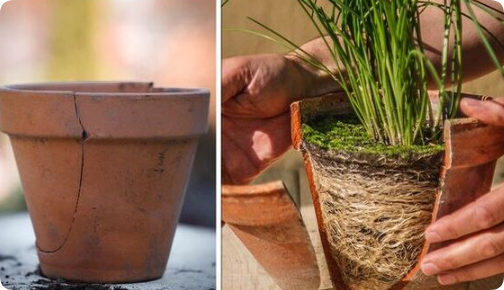Terracotta, known for its rustic appeal and breathability, is a popular choice for flower pots and decorative items. However, concerns about its durability in cold climates often arise, especially for B2B buyers who need reliable products for global distribution. This article addresses whether terracotta cracks in cold, the science behind it, and how to choose or modify terracotta to withstand freezing conditions.
Understanding Terracotta’s Material Properties
Terracotta is made from natural clay, fired at relatively low temperatures (around 1,000°C). Its porous structure makes it excellent for plant growth due to its breathability and water retention. However, the same porosity makes terracotta vulnerable to freezing, as water absorbed in the clay expands when frozen, potentially causing cracks.

Typically hollow, formed by pressing clay into a mold, by hollowing out portions of a solid, or by extruding it. Usually low-fired. Typically a reddish, unglazed ceramic material that may also be a hard-fired glazed or unglazed ceramic material.
Key Properties of Terracotta
| Property | Description |
|---|---|
| Porosity | High porosity allows water absorption, which can freeze and expand. |
| Strength | Less durable than materials like porcelain or ceramic when exposed to stress. |
| Flexibility | Low flexibility, leading to brittleness under rapid temperature changes. |
| Thermal Conductivity | Terracotta does not insulate well, causing rapid temperature shifts in cold weather. |
Why Terracotta Cracks in Cold Weather
- Water Absorption and Freezing:
Terracotta absorbs water due to its porous nature. In freezing temperatures, the absorbed water expands, creating pressure inside the material, which leads to cracks or even complete breakage. - Rapid Temperature Changes:
Quick transitions between warm and freezing temperatures cause thermal stress. Terracotta lacks flexibility to cope with these sudden shifts, increasing the risk of damage. - Low-Quality Manufacturing:
Terracotta that isn’t fired properly or is made from inferior clay tends to be more brittle, exacerbating its vulnerability to cold.
Can Terracotta Be Made Cold-Resistant?
B2B buyers often seek terracotta products suitable for diverse climates. Fortunately, several modifications can enhance terracotta’s cold resistance:
- Sealing the Surface:
Applying a waterproof sealant reduces water absorption, preventing freezing-related cracks. - High-Fire Terracotta:
Terracotta fired at higher temperatures becomes less porous and more durable, though it may lose some traditional rustic appeal. - Adding Grit or Sand:
Some manufacturers mix grit or sand into the clay to improve flexibility and reduce cracking risk. - Glazing:
Glazed terracotta offers an extra layer of protection, though it compromises the breathability that many plants require.
Flower pot winterization tips
Using a 10:1 water and PVA glue solution, fill a container large enough for your terra-cotta pot to be submerged. Dip for 30 seconds, drain and allow to dry for 24 hours. The pot should then be fully sealed against water penetration.
Comparison of Terracotta Modifications for Cold Resistance
| Modification | Effectiveness in Cold | Cost Implications | Suitability for Plants | Appearance |
|---|---|---|---|---|
| Sealant | Moderate | Low | Retains breathability | Maintains rustic look |
| High-Fire Terracotta | High | Moderate to High | Slightly reduced porosity | Less rustic, smoother |
| Adding Grit/Sand | Moderate to High | Low | Maintains breathability | Rustic look preserved |
| Glazing | High | Moderate | Limits breathability | Glossy or matte finish |
Advice for B2B Buyers
- For Large ODM Orders:
- Partner with manufacturers that offer high-fire or glazed terracotta options for regions with cold climates.
- Ensure the supplier provides cold-resistance testing reports or certifications.
- For Small OEM Orders:
- Opt for sealants or glazed finishes for added durability.
- Request samples to test the product’s cold tolerance before placing bulk orders.
- Packaging Matters:
Proper packaging for shipping can also prevent cold damage. For example, use insulated or padded materials to protect terracotta during transport to freezing regions.
Global Cold-Climate Markets for Terracotta Products
Countries with harsh winters, such as Canada, Sweden, and Russia, demand durable terracotta suitable for outdoor use. For such markets, promoting cold-resistant terracotta is crucial to ensuring customer satisfaction and repeat orders.
Conclusion
Terracotta can crack in cold if left untreated, but with the right modifications, it becomes a reliable option for cold climates. By understanding the material, exploring enhancements, and catering to market-specific needs, B2B buyers can confidently offer terracotta products that perform well even in freezing temperatures. For tailored solutions, partner with manufacturers offering ODM and OEM customization services.
By choosing Hale Planter, businesses can bulk up their planter offerings with confidence, knowing they will receive high-quality, durable, and aesthetically pleasing products that align with their brand vision and meet customer demands.
If you’re ready to take your planter business to the next level, reach out to Hale Planter today for consultation and bulk order opportunities.

